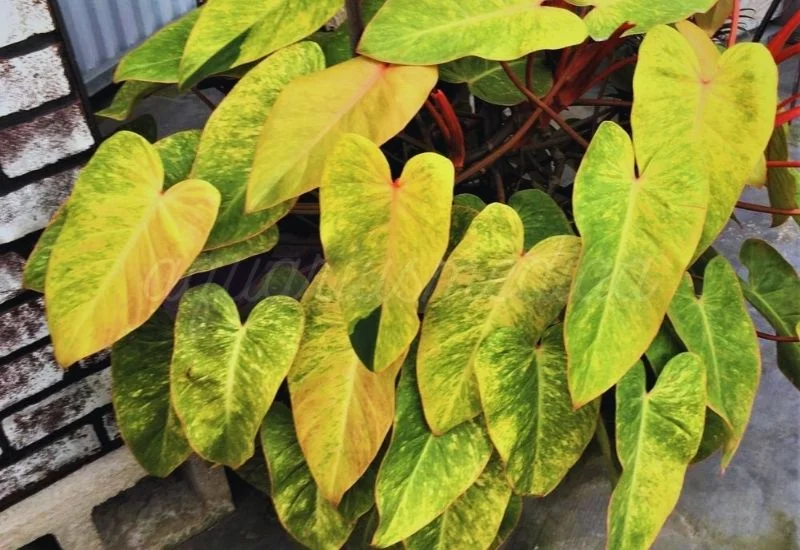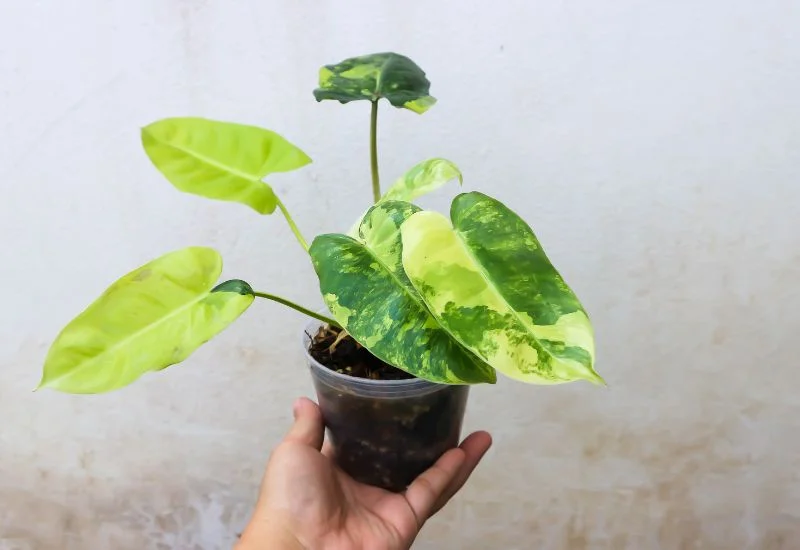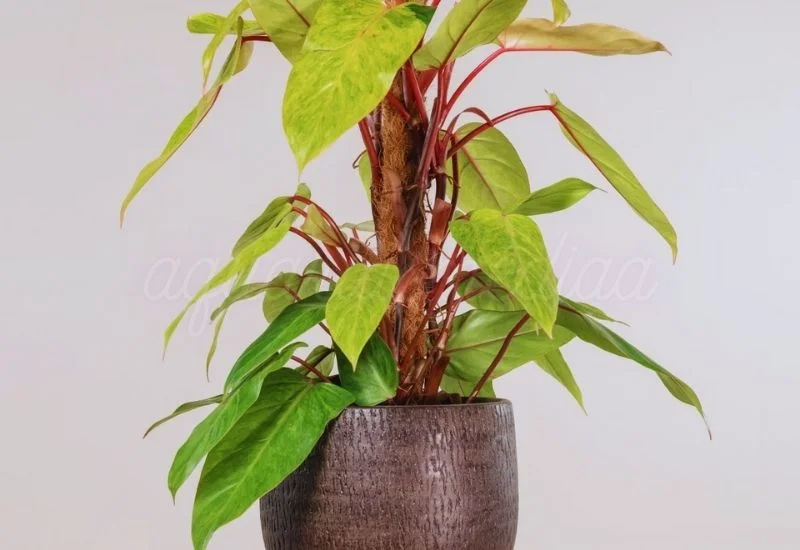In this blog post, you’re going to learn how to easily propagate and care for Painted Lady Philodendron.
This is a comprehensive guide covering reliable information about different aspects of this cultivated variety.
In this post, I’ll cover:
Interesting Facts
Propagation
Repotting
Care
And
Solutions to Common Problems
So, if you are looking to propagate and care for Painted Lady Philodendron, this guide is for you.
Fun Facts
| Common Name | Painted Lady Philodendron |
| Botanical Name | Philodendron erubescens ‘Painted Lady’ |
| Family | Araceae |
| Plant Type | Vining bature, Perenneil |
| Fruit | Not usually seen |
| Mature Size | 5 ft. tall, 3 ft. wide |
| Sun Exposure | Bright indirect light |
| Soil Type | Moist but well drained |
| Soil pH | acidic |
| Native Area | South America |
| Toxic | Toxic to both humans and pets |
| Growth | Fast-growing |
A plant that has been exceptionally decorated and fitted with bright and beautiful features is the Painted Lady Philodendron. It is similar to the other species of philodendron in many aspects like requirements of the indirect sunlight and a moist environment. It is also climbing in nature. So like other philodendrons, it should be grown using structures to grow up, such as moss poles.
The outstanding feature of the Painted Lady Philodendron is its leaf structure, which resembles raincoats. The leaves are large and broadly cordate and come in a beautiful two-toned yellow and green pattern with specks. However, depending on the age, the plant leaves become more prolonged, and the striping becomes more distinct.
The leaves of the Painted Lady Philodendron have a shiny surface and bright color that distinguish them from other indoor plants. That’s why many plant lovers love this plant.
Most Philodendron species have an average growth period that rises in warmer months. They can grow quite large; their stems are vines and will climb and grow spread or become floppy if given the room.
Flowering and Fruits

Like many other members of the genus Philodendron, it bears small, camouflaged flowers that usually go unnoticed.
These are usually small, white, or green and produced on a spadix embedded in a spathe. Plants produce flowers only once they grow in an outdoor space. Under favorable conditions these flowers convert into a ripened structure. It contains seeds that are useful in germination, although it is not very popular as vegetative propagation.
Benefits
Here is a look at some technical benefits of the painted lady philodendron, except the aesthetic appearance;
Vibrant Variegation
They have variegated foliage; bright yellow and green leaves are preferred to be placed even if they are inside the interior part of the house.
Unique Leaf Structure
These include the large, heart-shaped foliage with speckle patterning that contributes to the texture when incorporated into avant-garde and conventional homes.
Easy to Care For
This plant is indifferent to the external environment and excessively does not require periods of intensive care. It only needs simple interventions like watering at least once per week and fertilization once or twice a week. Therefore, it is perfect for even novice growers and collectors of the plant.
Resilience to Environmental Conditions
The Painted Lady Philodendron plant can adapt to the different indoor environments in which it can be placed, including changes in light and humidity.
Natural Air Cleaner
As with most philodendrons, the Painted Lady is also an air-purifying plant; thus, it removes formaldehyde and benzene gases from the air to make the environment healthier for living.
Enhanced Humidity
It can also help control the moisture levels inside a home, thus improving comfort, especially in dry climatic conditions.
Stress Reduction
Research has further indicated that those who have plants such as the Painted Lady Philodendron in their offices or at home stand to benefit from such plant interior decoration and health benefits also.
Boosts Productivity
Greenery like the Painted Lady Philodendron can enhance concentration and productivity, so it is recommended that it be placed in a home, office or any working area.
Propagation

The propagation of the painted lady philodendron is very easy. You have to select a healthy stem with at least two nodes. Use the sterilized blade to prevent any infection. Cut with the blade. After snipping, let the cut dry for some time to form a callus. This will prevent the rot when planted.
Dipping your cut into the rotting hormone can provide an edge for your growth rate. Fill the pot with well-drained soil, place the stem into it, and cover it with the soil. The nodes need to be buried, but the leaves need the sun. Keep the pot in bright indirect sunlight and water the soil. The soil must be moist, not soggy. Keep your propagation setup at a temperature between 70 °F and 75 °F. In several weeks, you will see the results.
Repotting
The painted lady philodendron is a slow-growing plant. You need to do repotting in 2 to 3 years. You will when it is time. The roots will come out from the drainage holes, and there will be no soil left. Repot the plant into the one size bigger pot.
Care
Here are the main care requirements to grow your painted lady philodendron:
Pruning
Pruning can be done at the start of the growing season, which is spring. You can cut the plant for more bushier growth rather than length. The painted lady philodendron does not need the cutting; it just needs maintenance. You can do that whenever you see dead leaves and stems. Use sterilized equipment for pruning.
Soil
The plant does best in the rich and airy soil. The soil should be well drained but can restore moisture as well and have a good amount of organic matter. The best pH level to grow is 6.1 to 7.3. For the soil of the plant, you can use peat moss, or you can use a commercial soil mix for your philodendron.
Pot
For your plant, use a pot made of ceramic material or one with drainage holes that allow excess water to escape. The size of the pot should be 1 to 2 inches wider than the root of the plant.
Water
Water the plant when the top inch of the soil feels dry. Add water thoroughly until the excess water comes out from the drainage holes. These plants are sensitive to overwatering. Make sure to mark the watering schedule. Plants need less watering in winter and fall as the plant’s growth slows down.
Light

To keep your plant healthy and in full growth, place it in a location where bright indirect sunlight is available. The plant needs indirect light to grow. Do not expose your plant to direct sunlight; it will burn the leaves. If you do not have enough natural light, you can use a grow light for your Painted Lady Philodendron. The plant can survive in less light as well, but it will become leggy over time.
Fertilizer
Use a liquid fertilizer for your plant. Add fertilization once a month after watering the plant. Use the fertilizer in summer and spring. Stop using it in the fall season when the temperature starts to fall.
Temperature and Humidity
The plant does best in warm environments; the needed temperature is 65 °F to 85 °F. The warmer the temperature, the more you need to water the soil. The plants do best in more humid areas but can do fine in home humid levels.
You can increase the humidity around the plants by placing a tray with pebbles and filling them with water. You can also choose a more humid room in the house to benefit the plant or group it with other plants to increase humidity.
Placement
The best place for the placement of the painted lady philodendron is 3 to 4 feet away from the window facing east or west. These plants enjoy at least 3 to 4 hours of bright indirect light. If you do not have the perfect window, you can use plant lights.
Common Problems

Here are some common problems that every plant owner faces:
Pests
There are some common pests like spider mites, mealybugs, and scales. They live under the leaves of your plant and consume them. These bugs can attract more insects like ants, which further damage your plant.
To prevent any residue from these bugs, you need to inspect your plant daily. If you find any bugs, you can wipe them off with a cotton swab in rubbing alcohol. You can also use a spray solution that will kill the bugs.
Fungal Diseases
Fungal diseases are so common that every plant owner faces this problem once in a while. The fungal and bacterial diseases are caused by overwatering. Overwatering leads to root rot. The main symptoms of fungal disease are turning the leaves yellow and the smell from the roots. To save your plant, cut the affected parts and add the fresh soil into the pot.
Brown Tips
This is the other most common problem in household plants. The reasons for this are very few. This can be due to more exposure to light or less humidity. Place your plant in an indirect sunlight area and increase the humidity level around the plant.
Curling Leaves
The curling leaves of the plants can be due to the underwatering, pets, and environmental stress. The pets start to eat the leaves, which leads to the curling leaves. Watch the watering schedule and inspect your plant for any bugs.
Yellow Leaves
Yellow leaves are a common issue in every household. The yellow leaves are the oldest leaves or the dying ones. But if you notice the new leaves are turning yellow, then there is a problem. Mostly, plant leaves turn yellow because of less light and underwatering; the reason can be reversed, like overwatering and more exposure to light. Place your plant where the intensity of light is perfect, and water your schedule for watering your painted lady philodendron.
Toxicity
The painted lady philodendron is toxic to pets and humans. Calcium oxalate crystals are found in all parts of the plant. Avoid handling the plant without gloves due to its toxicity.It will get you an immediate reaction even while handling it.
It can cause itching and rash when it comes into contact with the skin. The plant is toxic for household pets such as cats, dogs, and rabbits. If your pet has eaten the plant, he will be wheezing and vomiting. Take them to the vet immediately.
Varieties & Similar Plants

Here is the list of varieties and similar plants of painted lady philodendron:
Varieties
- Philodendron ‘Congo Rojo’
- Philodendron ‘Brasil’
- Philodendron ‘Moonlight’
Similar Plants
- Monstera deliciosa ‘Albo-Variegata’
- Epipremnum aureum ‘Golden Pothos’
- Philodendron ‘Birkin’
- Philodendron ‘Prince of Orange’
